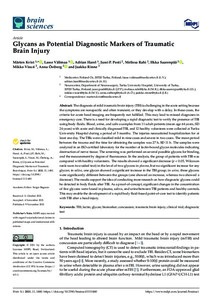Glycans as Potential Diagnostic Markers of Traumatic Brain Injury
Kvist Mårten; Välimaa Lasse; Harel Adrian; Posti Jussi P; Rahi Melissa; Saarenpää Ilkka; Visuri Mikko; Östberg Anna; Rinne Jaakko
https://urn.fi/URN:NBN:fi-fe2022012711003
Tiivistelmä
The diagnosis of mild traumatic brain injury (TBI) is challenging in the acute setting because the symptoms are nonspecific and often transient, or they develop with a delay. In these cases, the criteria for acute head imaging are frequently not fulfilled. This may lead to missed diagnoses in emergency care. There is a need for developing a rapid diagnostic test to verify the presence of TBI using body fluids. Blood, urine, and saliva samples from 11 adult patients (mean age 64 years, SD 24 years) with acute and clinically diagnosed TBI, and 12 healthy volunteers were collected at Turku University Hospital during a period of 5 months. The injuries necessitated hospitalization for at least one day. The TBIs were classified mild in nine cases and severe in two cases. The mean period between the trauma and the time for obtaining the samples was 27 h, SD 11 h. The samples were analyzed in an ISO-certified laboratory for the number of lectin-bound glycan molecules indicating destruction of nerve tissue. The screening was performed on several possible glycans for binding, and the measurement by degree of fluorescence. In the analysis, the group of patients with TBI was compared with healthy volunteers. The results showed a significant decrease (p < 0.05, Wilcoxon rank–sum two-sided test) in the level of two glycans in plasma, but no significant increase for any glycan; in saliva, one glycan showed a significant increase in the TBI group; in urine, three glycans were significantly different between the groups (one showed an increase, whereas two showed a decrease). The results support the idea of conducting more research on how diagnostic glycans could be detected in body fluids after TBI. As a proof-of-concept, significant changes in the concentration of five glycans were found in plasma, saliva, and urine between TBI patients and healthy controls. This may enable the development of a rapid body fluid-based point-of-care test to identify patients with TBI after a head injury.
Kokoelmat
- Rinnakkaistallenteet [27094]
